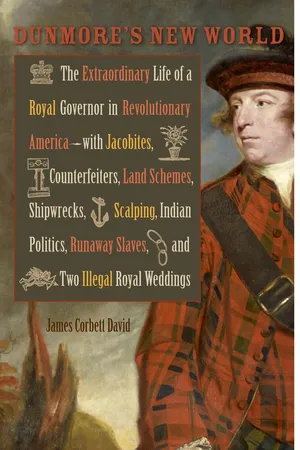
Dunmore's New World
The Extraordinary Life of a Royal Governor in Revolutionary America--with Jacobites, Counterfeiters, Land Schemes, Shipwrecks, Scalping, Indian Politics, Runaway Slaves, and Two Illegal Royal Weddings
- 280 pages
- English
- ePUB (mobile friendly)
- Available on iOS & Android
Dunmore's New World
The Extraordinary Life of a Royal Governor in Revolutionary America--with Jacobites, Counterfeiters, Land Schemes, Shipwrecks, Scalping, Indian Politics, Runaway Slaves, and Two Illegal Royal Weddings
About this book
Dunmore's New World tells the stranger-than-fiction story of Lord Dunmore, the last royal governor of Virginia, whose long-neglected life boasts a measure of scandal and intrigue rare in the annals of the colonial world. Dunmore not only issued the first formal proclamation of emancipation in American history; he also undertook an unauthorized Indian war in the Ohio Valley, now known as Dunmore's War, that was instrumental in opening the Kentucky country to white settlement. In this entertaining biography, James Corbett David brings together a rich cast of characters as he follows Dunmore on his perilous path through the Atlantic world from 1745 to 1809.
Dunmore was a Scots aristocrat who, even with a family history of treason, managed to obtain a commission in the British army, a seat in the House of Lords, and three executive appointments in the American colonies. He was an unusual figure, deeply invested in the imperial system but quick to break with convention. Despite his 1775 proclamation promising freedom to slaves of Virginia rebels, Dunmore was himself a slaveholder at a time when the African slave trade was facing tremendous popular opposition in Great Britain. He also supported his daughter throughout the scandal that followed her secret, illegal marriage to the youngest son of George III—a relationship that produced two illegitimate children, both first cousins of Queen Victoria.
Within this single narrative, Dunmore interacts with Jacobites, slaves, land speculators, frontiersmen, Scots merchants, poor white fishermen, the French, the Spanish, Shawnees, Creeks, patriots, loyalists, princes, kings, and a host of others. This history captures the vibrant diversity of the political universe that Dunmore inhabited alongside the likes of George Washington and Thomas Jefferson. A transgressive imperialist, Dunmore had an astounding career that charts the boundaries of what was possible in the Atlantic world in the Age of Revolution.
Frequently asked questions
- Essential is ideal for learners and professionals who enjoy exploring a wide range of subjects. Access the Essential Library with 800,000+ trusted titles and best-sellers across business, personal growth, and the humanities. Includes unlimited reading time and Standard Read Aloud voice.
- Complete: Perfect for advanced learners and researchers needing full, unrestricted access. Unlock 1.4M+ books across hundreds of subjects, including academic and specialized titles. The Complete Plan also includes advanced features like Premium Read Aloud and Research Assistant.
Please note we cannot support devices running on iOS 13 and Android 7 or earlier. Learn more about using the app.
Information
Notes
Abbreviations
AA | [Peter Force], ed. American Archives. 4th ser., vols. 1, 3, 4. Washington, D.C.: M. St. Clair Clarke and Peter Force, 1837, 1840, 1843 |
A.O. | Great Britain, Audit Office Papers, Records of the American Loyalist Claims Commission, 1776–1831 |
C.O. | Great Britain, Colonial Office Papers |
DC | “Dunmore Correspondence, 1771–1778,” Special Collections, John D. Rockefeller Jr. Library, Williamsburg, Va. |
DFP | Dunmore Family Papers, National Records of Scotland, Edinburgh |
DHDW | Reuben Gold Thwaites and Louise Phelps Kellogg, eds. Documentary History of Dunmore’s War, 1774. Madison: Wisconsin Historical Society, 1905 |
Documents Relative | E. B. O’Callaghan, ed. Documents Relative to the Colonial History of the State of New-York. Vol. 8. Albany: Weed, Parsons, 1857 |
HNP | Hamond Naval Papers, Accession #680, Albert and Shirley Small Special Collections Library, University of Virginia, Charlottesville |
LPCC | Cadwallader Colden. Letters and Papers of Cadwallader Colden, vols. 7, 9. Collections of the New-York Historical Society 56, 68 (1923, 1937) |
NDAR | William Bell Clark et al., eds. Naval Documents of the American Revolution. Vols. 1–8. Washington, D.C.: U.S. Government Printing Office, 1964–80 |
NRAS | National Register of Archives for Scotland |
NRS | National Records of Scotland |
PGWC | George Washington. The Papers of George Washington, Colonial Series. Vols. 8–10. Edited by W. W. Abbot et al. Charlottesville: University Press of Virginia, 1993–95 |
PGWR | George Washington. The Papers of George Washington, Revolutionary War Series. Vols. 1–15. Edited by W. W. Abbot et al. Charlottesville: University of Virginia Press, 1985–2006 |
PWJ | William Johnson. The Papers of Sir William Johnson. Vols. 7, 8, 12, 13. Edited by Milton Hamilton. Albany: University of the State of New York, Division of Archives and History, 1931–62 |
RV | William J. Van Schreeven and Robert L. Scribner, eds. Revolutionary Virginia: The Road to Independence. Vols. 1–7. Charlottesville: University Press of Virginia, 1973–83 |
VG | Virginia Gazette (with editor information) |
Introduction
ONE. Family Politics, 1745–1770
Table of contents
- Cover
- Title
- Copyright
- Contents
- List of Illustrations
- Acknowledgments
- Introduction
- One Family Politics, 1745–1770
- Two The Absence of Empire, 1770–1773
- Three Promised Land, 1773–1774
- Four A Refugee’s Revolution, 1775–1781
- Five Abiding Ambitions, 1781–1796
- Conclusion, 1796–1809
- A Note on Method: Biography and Empire
- Notes
- Bibliography
- Index